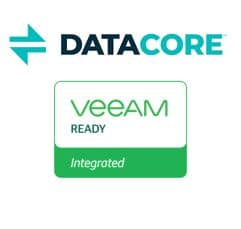Any questions, remarks or additions: melter[at]idicos.de
SANsymphony meets Veeam Backup and Replication – true love in the end!
In December 2019 the plugin for the popular DataCore SANsymphony SDS was finally released. And it is done in the only proper way: With full support and validation by Veeam.
In this article series we will cover several aspects of the plugin:
- Scope, features and license requirements for Veeam (just read on)
- Installation and configuration
- BfSS Jobs
- Manual snapshots and snapshot-only jobs
- Recovery from snapshots
- Off-label usage together with CDP
Universal-Storage-API
Vendor specific storage integration is an easy and straightforward way to enhance your Veeam backup strategy in many aspects.
Together with Version 9.5 U3 Veeam released its Universal Storage API back in 2017. Since then several storage vendors, both physical and virtual, started to provide plugins for this API.
These plugins are always created by the storage vendors but are validated by and delivered via Veeam. Therefore, Veeam can provide full support for the plugin. Though the documentation of the plugins is quite brief and generic, as it has to fit every vendor that the Universal Storage API integrates. This is where I had the idea for a series of blog posts to fill this gap for DataCore here.
Scope and features
In this first post of the series I’ll give an overview of the functionality of the plugin. We will also discuss the license requirements for Veeam to be able to use different aspects of the plugin.
With DataCore SANsymphony being a software defined storage system, the plugin generally enables every physical storage system behind the DataCore layer for native storage support inside VBR. Even older systems or entry-level systems could therefore gain full storage integration from Veeam.
What does Veeam talk about with saying “storage support” in the first place?
We have to differentiate two specific features in general:
- Backup-from-Storage-Snapshots (BfSS)
- Snapshot-Only-Jobs
License requirements
BfSS (1) can be considered an enhancement for regular primary backup jobs. The SLAs for certain Workloads during their backup windows can be guaranteed by enabling it. To be able to use BfSS, you will need to have an Enterprise Plus license for your Veeam installation. This can be a socket license or the new VUL subscription license. The latter always comes as an Enterprise Plus edition.
Snapshot-Only-Jobs (2) do not have special license requirements inside Veeam. Even the community edition is able to leverage them. With a snapshot only job you can generate a Veeam primary backup job that is not pointing to a regular repository. Instead it shows a storage snapshot as its repository. By running this job, only a snapshot in the underlying storage system – in our case here DataCore SANsymphony – is generated. This takes only a few seconds. Yet in the Veeam interface the snapshot shows up as a full backup. You are able to recover a full VM from it using instant-recovery. Also, you can recover guest files or even application objects from this snapshot. Storage snapshots can be generated fast and multiple times with (almost) no impact on the production environment. This can dramatically minimize your RPO by using them in your Veeam backup strategy.
We will deep-dive into both methods as well as your recovery options in four following posts. We will also look into some off-label methods, you wont find in the Veeam guides.
In the following links you’ll find some basic info from DataCore and Veeam.
https://www.datacore.com/blog/veeam-backup-integration/
https://www.veeam.com/blog/datacore-sansymphony-plugin.html
The extensive deepdive is ready for you on the following pages.


Hi All,
Good News on the way, Datacore PSP14 will come soon and will give new features through CDP. Thanks to this update Veeam will be able to directly access the Datacore CDP. No more need Datacore Snapshot. Big Data economy and big flexybility.
Veeam normaly will update VBR just after and thats’it. We’ll all be able to recover a VM or guest files from reading Datacore CDP in point in time. (depending on how much you allocated to DC CDP for sure)
Hi Loïc.
Thanks for the update. To my knowledge it will even be uncoupled from PSP14 and is to be released as an updated plugin pretty soon.
An update to the blog post will follow. In general it will deliver the same outcome but the process will be much easier to handle.
Great news for DataCore users having a slight fear of ransomware (who does not?). 😉
Hi All,
which SAU size would you recommend for the snapshot pool?
If you use CDP, is there any advisory which SAU size should be used?
I read the Veeam digest from gostev. Veeam released the CDP feature in their updated Datacore plugin. I’m really looking forward to your blog post update.
Hi Alfred.
For a pure snapshot pool one might want to go as small as possible. I usually stick with 8 MB. 4 MB could also be an option. The smaller, the longer the pool can support your snapshots.
For CDP I did not find a best-practice recommendation. Through talks to DataCore SEs I narrowed my personal best-practice to 32MB as a trade off between overhead and granularity.